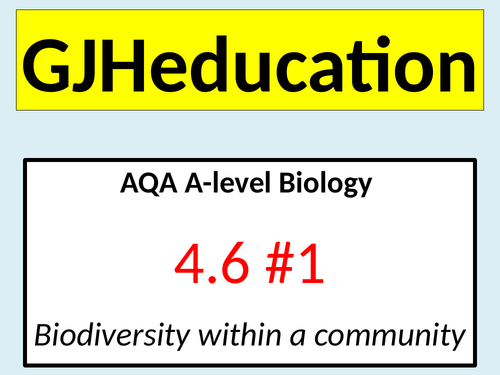








This lesson describes the meaning of biodiversity, explains how it relates to a range of habitats, and describes how to calculate an index of diversity. The PowerPoint and accompanying worksheets are part of the first in a series of 2 lessons that have been designed to cover the content of topic 4.6 of the AQA A-level Biology specification. The second lesson describes the balance between conservation and farming.
A quiz competition called BIOLOGICAL TERMINOLOGY SNAP runs over the course of the lesson and this will engage the students whilst challenging them to recognise species, population, biodiversity, community and natural selection from their respective definitions. Once biodiversity as the variety of living organisms in a habitat is revealed, the students will learn that this can relate to a range of habitats, from those in the local area to the Earth. When considering the biodiversity of a local habitat, the need for sampling is discussed and some key details are provided to initially prepare the students for these lessons in topic 7. Moving forwards, the students will learn that it is possible to measure biodiversity within a habitat, within a species and within different habitats so that they can be compared. Species richness as a measure of the number of different species in a community is met and a biological example in the rainforests of Madagascar is used to increase its relevance. The students are introduced to an unfamiliar formula that calculates the heterozygosity index and are challenged to apply their knowledge to this situation, as well as linking a low H value to natural selection. The rest of the lesson focuses on the index of diversity and a 3-step guide is used to walk students through each part of the calculation. This is done in combination with a worked example to allow students to visualise how the formula should be applied to actual figures. Using the method, they will then calculate a value of d for a comparable habitat to allow the two values to be considered and the significance of a higher value is explained. All of the exam-style questions have mark schemes embedded in the PowerPoint to allow students to continuously assess their progress and understanding.
Get this resource as part of a bundle and save up to 39%
A bundle is a package of resources grouped together to teach a particular topic, or a series of lessons, in one place.
Topic 4: Genetic information, variation and relationships between organisms (AQA A-level Biology)
Every one of the lessons included in this bundle is detailed, engaging and fully-resourced, and has been written to cover the content as detailed in topic 4 of the AQA A-level Biology specification. The wide range of activities will maintain engagement whilst supporting the explanations of the content to allow the students to build a deep understanding of genetic information, variation and relationships between organisms. The following 17 lessons covering the 7 sub-topics are included in this bundle: 4.1: DNA, genes and chromosomes * DNA in prokaryotes and eukaryotes * Genes 4.2: DNA and protein synthesis * Genome, proteome and the structure of RNA * Transcription and splicing * Translation 4.3: Genetic diversity can arise as a result of mutation or during meiosis * The genetic code * Gene mutations * Chromosome mutations * Meiosis 4.4: Genetic diversity and adaptation * Genetic diversity * Natural selection * Adaptations 4.5: Species and taxonomy * Species and taxonomy 4.6: Biodiversity within a community * Biodiversity within a community * Calculating an index of diversity * The balance between conservation and farming 4.7: Investigating diversity * Investigating diversity * Interpreting mean values and the standard deviation If you would like to sample the quality of the lessons in this bundle, then download the DNA in prokaryotes and eukaryotes, structure of RNA, gene mutations, natural selection and standard deviation lessons as these have been uploaded for free
Topics 4.4 - 4.7 (AQA A-level Biology)
These 7 lessons are highly detailed and are filled with a wide range of tasks that will engage the students whilst covering the following specification points in topics 4.4, 4.5, 4.6 and 4.7 of the AQA A-level Biology specification: 4.4 Genetic diversity as the number of different alleles of genes in a population and a factor enabling natural selection to occur The principles of natural selection in the evolution of populations Directional and stabilising selection Natural selection results in anatomical, physiological or behavioural adaptations 4.5 Two organisms belong to the same species if they are able to produce fertile offspring The taxonomic hierarchy comprising domain, kingdom, phylum, class, order, family, genus and species The use of the binomial name to identify species 4.6 Biodiversity can relate to a range of habitats Species richness Calculating an index of diversity 4.7 Investigating genetic diversity with, or between species, by comparing observable characteristics or nucleic acids and the structure of proteins Calculating and interpreting the mean and standard deviation If you download the natural selection and standard deviation lessons which have been shared for free then you will be able to see the quality of lessons included in this bundle
Something went wrong, please try again later.
This resource hasn't been reviewed yet
To ensure quality for our reviews, only customers who have purchased this resource can review it
Report this resourceto let us know if it violates our terms and conditions.
Our customer service team will review your report and will be in touch.